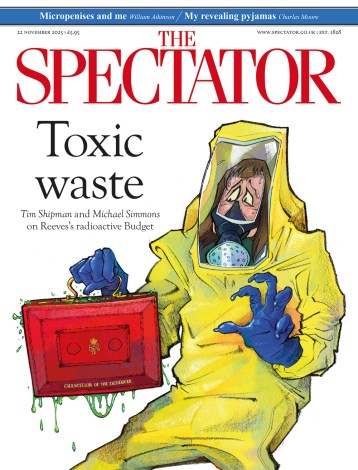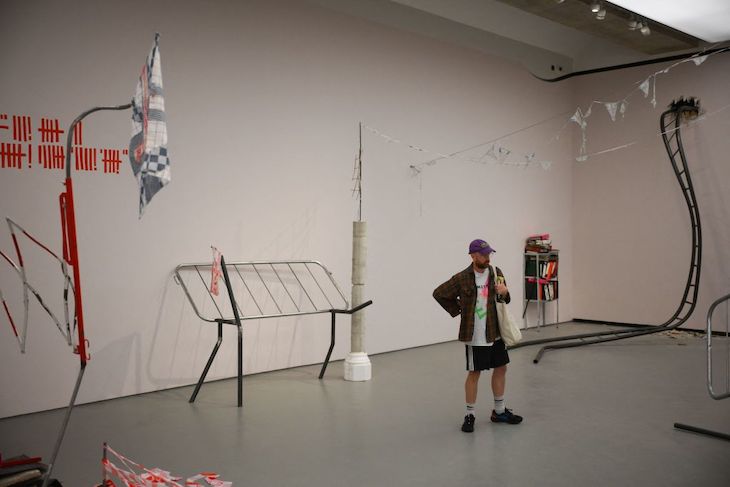In 1950 the American critic Lionel Trilling suggested, in his book The Liberal Imagination, that there was no meaningful right-wing philosophy in the US. ‘The conservative impulse and the reactionary impulse do not… express themselves in ideas but only in action or in irritable mental gestures which seek to resemble ideas.’ He was giving voice to a venerable, and continuing, strain in left-liberal thought which regards conservatism as little more than incoherent grumbling about inevitable and irresistible change. In this view, such change is, naturally, best managed by those clever, mature left-liberals.
Conceptual art has, like so many previous artistic movements, run out of steam
There is a grain of truth in Trilling’s claim, insofar as a good deal of conservative politics involves pragmatic, practical people trying to limit or repair the damage done by the crackpot schemes of intellectuals. But the problem of intellectual or artistic traditions degenerating into reaction, repetition and pastiche is hardly limited to political conservatism.
Which brings us to the Turner prize, and conceptual art more broadly. It was announced a few days ago that this year’s prize winner was Jesse Darling, whose winning piece was the usual mish-mash of found objects loosely tied together with some political waffle about Brexit and racism. All very predictable, all very safe – to be honest, I can feel my attention wandering as I type. It seems like a waste of mental energy even to think about it for more than a couple of minutes. I know that I am the sort of person modern artists want to annoy and upset with their work, and am therefore reluctant to give them the satisfaction of having shocked uptight provincial squares.
The thing is, I’m not shocked. I’m bored, because conceptual art has, like so many previous artistic movements, run out of steam. It has become unmoored from its original impetus, bogged down in the same old clichés and glib political posturing – irritable mental gestures, if you will. The argument put forward by the pioneers of conceptualism in the mid-twentieth century was that the traditional forms and idioms of visual art were exhausted and inadequate for the modern age, and that political comment and theoretical interrogation of the very concept of art needed to become integral to their work. An out-of-touch establishment was throttling new ideas, therefore that establishment needed to be rejected and replaced. Nowadays, though, conceptualism is the establishment. Duchamp’s ‘Fountain’, which was the most high-profile if not the first piece of conceptual art in the modern sense, appeared more than a century ago. We are now six or seven decades on from the first self-consciously conceptual artists, and the extent of the political and cultural insight generated seems to be ‘being left-wing is good’. There is little apparent interest in creating beauty or illuminating enduring truths about the world – partly, of course, because art has become entangled with ideologies that regard beauty and truth as little more than social constructs used to shore up the power of the dominant classes.
Artistic movements that spring from opposition or antagonism to something else, or have a political edge, are always going to struggle to maintain enduring interest or worth in the longer term, because they are engaged in an essentially negative endeavour. Conceptual art, like a lot of modern art, has this difficulty.
The early generations of conceptualists (and modernists) had mostly been educated in the old tradition, or were at least familiar with it. When they lamented the restrictions of figurative or representational art, they had a clear idea of what they were talking about. But contemporary practitioners are at least two or three generations removed from the classic tradition. They weren’t raised in the old world; they don’t know much about it. They certainly don’t understand it. The alleged straitjackets once imposed on the free artistic spirit by that tradition are a kind of folk devil, a mythologised enemy which no longer really exists. The same is true of those other frequently invoked antagonists for modern artists, the conservative establishment, or the conventional middle-class who need to be shocked out of their prim complacency. There is no coterie of arch-conservative bishops, minor gentry, and retired colonels secretly running everything. There are no easily shocked bourgeoisie having fits of the vapours because a play features nudity. It is no longer 1952. Art which takes anti-conservatism as its foundation or core principle is merely bombing the rubble of a long-defeated city.
This problem is not confined to the visual arts. In poetry, early modernists like Walt Whitman or TS Eliot used free verse, and crafted complex webs of reference and allusion, to reimagine what could be done with the medium. For the American Whitman that meant rejecting the strict ideas about structure and subject matter that still dominated the poetic culture of Europe – the Old World – and creating a vigorous new democratic idiom for the young, energetic United States, which during his lifetime (1819-92) transformed from a relatively marginal agrarian nation into a proto-superpower.
Eliot (1888-1965) was also an American by birth but a naturalised Briton. He saw that the transformation of western culture in his time, especially the cataclysm of the first world war, required a wholly new poetry to address the fragmentation, dislocation and alienation experienced in the modern world. Eliot and Whitman’s poems are undoubtedly difficult, but rarely are they obscure for obscurity’s sake. And – particularly in Eliot’s case – they are in conversation with the great tradition. They take for granted that beauty and meaning really do exist. They have a positive vision.
Many of their successors, however, seem to regard deeply obscure imagery, and the rejection of structure and rhyme, as ends in themselves. Or that these things are sufficient to be ‘authentic’ (and therefore, supposedly, good). Like conceptual artists, they are reacting against a largely vanquished and forgotten enemy – the old poetic requirements concerning metre, rhyme and form, which have been out of fashion since long before most people reading this were born.
The near-inevitable rebuttal to these kind of arguments is that the person making them is a mere reactionary. This is not the case. I suppose I am an artistic conservative, in that I believe art should aim for truth and beauty, but there are different ways to show truth and beauty, and many of those ways do not require traditional forms. I am fond of the new Coventry cathedral, and Bridget Riley paintings and Henry Moore sculptures and the buildings of Frank Lloyd Wright. My objection is not to certain forms of art but to glib, uninspired and tired approaches. The current conceptual scene offers unparalleled opportunities for the untalented and lazy.






Comments